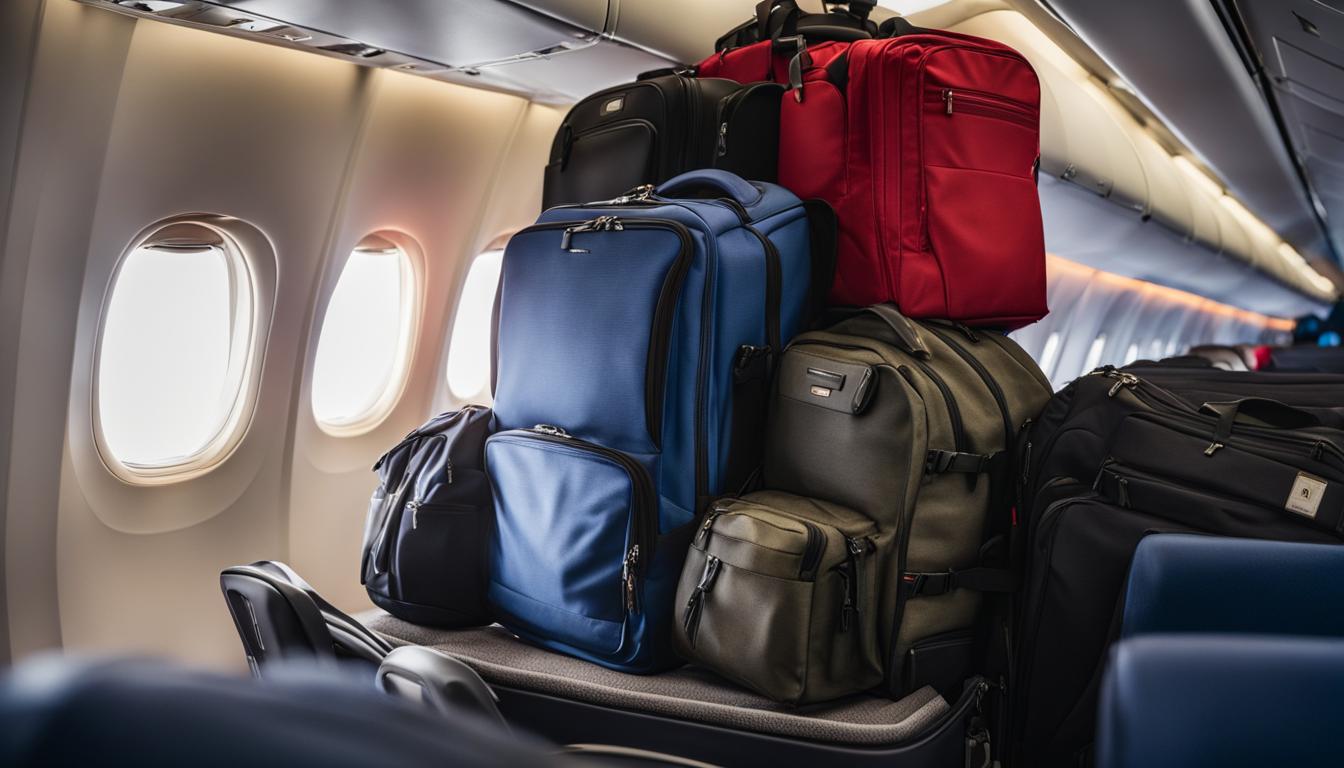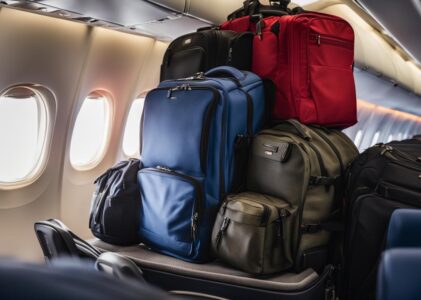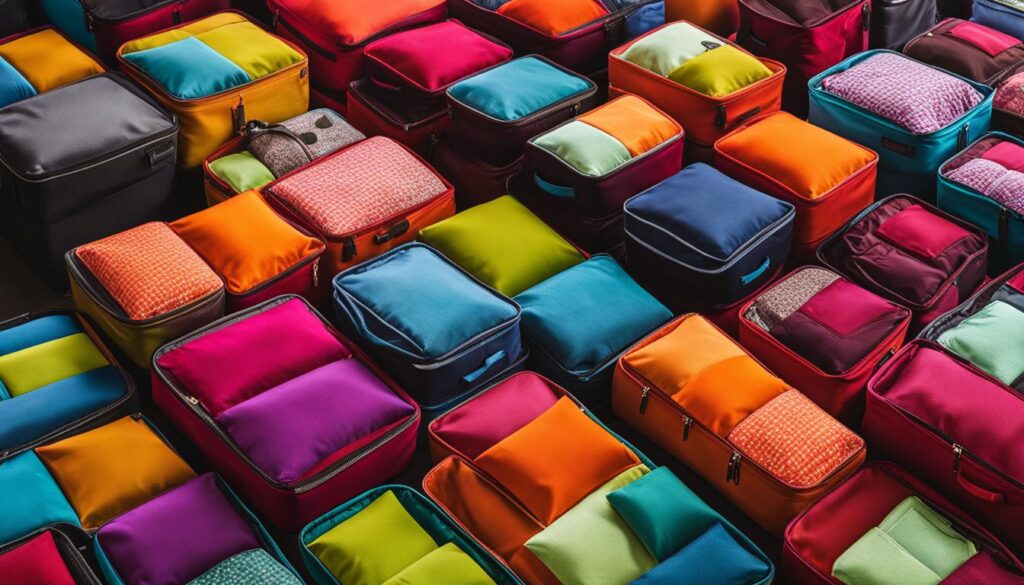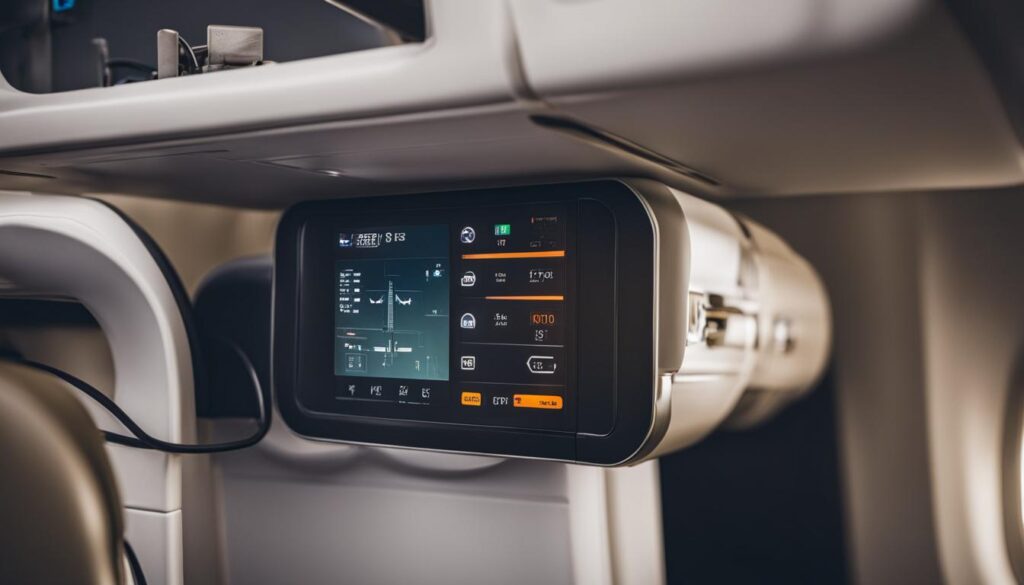Are you tired of lugging around heavy luggage while traveling? Do you want to simplify your travel experience and save money on checked baggage fees? If so, you may be wondering if you can use a backpack as a carry on.
The answer is yes, you can use a backpack as a carry on, but there are rules and regulations that you must follow. In this comprehensive guide, I will provide you with all the essential information you need to know about airline carry on regulations and how to use a backpack as a carry on for hassle-free travel.
Key Takeaways:
- Using a backpack as a carry on is allowed by most airlines, but there are specific size restrictions that must be followed.
- Understanding airline carry on regulations and TSA guidelines is crucial to ensure a smooth travel experience.
- Packing efficiently and utilizing additional space, such as carrying a small backpack as a personal item, can make traveling with a carry on backpack even more convenient.
- By complying with airline baggage rules and following expert tips, you can enjoy the benefits of using a backpack as a carry on, including ease of movement and practicality.
- Always check with your specific airline for any additional rules or restrictions regarding using a backpack as a carry on.
Understanding Airline Carry On Regulations
Before we dive into using a backpack as a carry on, let’s first familiarize ourselves with the airline carry on regulations. Each airline has specific rules regarding the size, weight, and number of bags you can bring on board. Not adhering to these regulations can result in additional fees or having to check your luggage.
Carry On Luggage Size Restrictions
One of the essential things to note is the carry on luggage size restrictions. Most airlines allow a carry on bag with dimensions of up to 22 x 14 x 9 inches, including handles and wheels. However, it’s always best to double-check with your specific airline as some may have different size requirements.
If you’re unsure what size your backpack is, measure it before traveling. Remember to measure the length, width, and height with wheels and handles included.
Airline Baggage Rules
Along with luggage size restrictions, airlines have their own baggage rules. Some airlines may have weight limits for carry on bags, while others may allow an additional personal item in addition to a carry on bag. Checking your airline’s baggage rules beforehand can help you avoid any unexpected surprises.
Another thing to keep in mind is that some airlines may have stricter rules for carry on bags for smaller regional jets. Be sure to check these rules before your flight to avoid issues at the airport.
Remember, airlines’ carry on regulations are subject to change, so always double-check with your specific airline before traveling.
Backpack Size for Carry On: What to Consider
Choosing the right backpack size for your carry on is crucial to ensure that it meets airline regulations. Here are some factors you should consider:
- The airline’s carry on size restrictions: Before purchasing a backpack, make sure to check the airline’s carry on size restrictions. Different airlines have different size limitations, so it’s important to choose a backpack that meets the specific requirements of your airline.
- Your travel needs: Consider how long your trip will be and what items you will need to bring. If you’re only traveling for a few days, a smaller backpack may be sufficient. However, for longer trips, you may need a larger backpack to accommodate all your belongings.
- Your physical abilities: If you have back or shoulder issues, it may be better to opt for a smaller backpack that is easier to carry. Additionally, if you’re short in height, a large backpack may look disproportionate on your body and may also be difficult to carry.
When shopping for a backpack for carry on, look for one that has multiple compartments and pockets. This will help you stay organized and make it easier to access your items during travel. A backpack with padded straps and a back panel can also help provide comfort during long periods of wear.
Backpack Size Comparison Table
| Backpack Model | Dimensions | Capacity |
|---|---|---|
| The North Face Borealis Backpack | 19.75″ x 13.5″ x 8.5″ | 28 liters |
| Osprey Porter 46 Travel Backpack | 22″ x 14″ x 9″ | 46 liters |
| Eagle Creek Global Companion Travel Pack | 25″ x 13″ x 10″ | 65 liters |
Note: The dimensions of the backpack may vary depending on the maker and the style.
It’s important to remember that the size of your backpack isn’t the only factor airlines consider when determining whether it’s acceptable as a carry on. The weight of your backpack is also a factor to consider, and some airlines have weight restrictions in addition to size restrictions.
TSA Guidelines for Carry On Bags
When it comes to packing your carry on backpack, it’s important to adhere to the TSA guidelines to ensure a smooth experience at airport security checkpoints. Here are some essential tips to keep in mind:
- Size Restrictions: The TSA allows carry on bags that measure up to 22 x 14 x 9 inches (including handles and wheels). Make sure your backpack fits within these guidelines.
- Liquid Limitations: All liquids, gels, and aerosols brought on board must be placed in a quart-sized clear plastic bag. Each container can hold no more than 3.4 ounces.
- Electronics: Laptops, tablets, and other electronics larger than a cell phone must be removed from your backpack and placed in a separate bin during screening.
- Restricted Items: Some items are prohibited in carry on bags, including firearms, explosives, and certain sharp objects. Make sure to check the TSA’s list of prohibited items before packing.
By following these guidelines, you can help speed up the security screening process and avoid any unnecessary delays or issues.
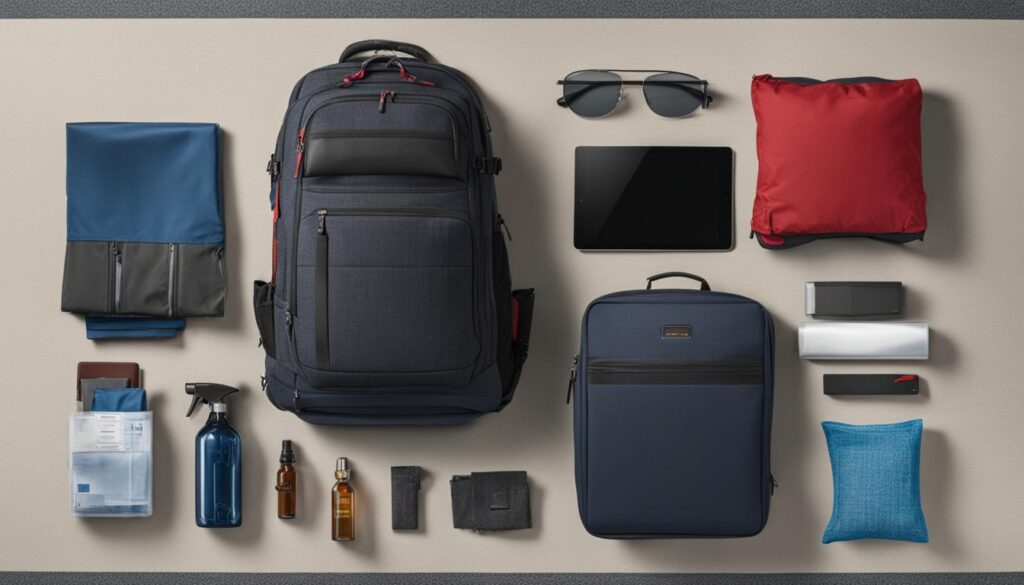
Smart Packing Tips for Carry On Backpacks
As with any trip, packing efficiently is key to hassle-free travel. Here are some smart packing tips for your carry on backpack:
- Roll your clothes: Rolling clothes instead of folding them will save space and minimize wrinkles.
- Maximize space: Fill empty spaces in your backpack with small items such as socks or underwear.
- Use packing cubes: These handy organizers help you compartmentalize your items and make unpacking a breeze.
- Wear bulky items: Don’t waste space in your backpack for bulky items like jackets or heavy shoes – wear them on the plane instead.
- Choose versatile clothing: Pack clothes that can be worn in multiple ways, maximizing outfit options while minimizing the number of items you need to bring.
Remember to avoid overpacking, as this can lead to a heavy backpack that’s difficult to maneuver. Stick to the essentials and leave any unnecessary items at home.
Sample Packing List for a Weekend Trip:
| Item | Quantity |
|---|---|
| Tops | 3 |
| Bottoms | 2 |
| Underwear | 3 |
| Socks | 3 |
| Pajamas | 1 |
| Toiletries | 1 set |
| Electronics (phone and charger, headphones, etc.) | 1 set |
| Travel documents (passport, boarding pass, etc.) | 1 set |
With these packing tips and a streamlined packing list, you’ll be able to make the most of your carry on backpack and enjoy stress-free travel.
Using a Backpack as a Personal Item
As a savvy traveler, you know that packing smart is the key to a hassle-free trip. Did you know that many airlines allow a personal item in addition to a carry on? You can take advantage of this by using your backpack as a personal item.
When using a backpack as a personal item, it is important to keep in mind the size limitations set by the airline. Typically, personal items should fit under the seat in front of you and should not exceed 18 x 14 x 8 inches. This size is perfect for a small daypack or a compact backpack.
Having a backpack as a personal item offers a lot of flexibility. You can use it to store items you will need during the flight, such as a book or headphones while keeping your larger carry on bag overhead. This way, you will have easy access to your essentials without having to reach for the overhead compartment.
Another advantage of using a backpack as a personal item is that it can save you money. Some airlines charge for carry on bags, but most allow one carry on bag plus a personal item for free. By using your backpack as a personal item, you can avoid paying extra fees for additional bags.
Make sure to pack your personal item carefully and efficiently. Consider packing items like a water bottle, snacks, a small travel pillow, and a light jacket. This way, you can stay comfortable during the flight. You can also use packing cubes to keep everything organized and easy to find.
Pro tip:
If you are traveling with a partner or friend, consider sharing a backpack as a personal item. This will save you both some money and allow you to bring more items on board without exceeding airline restrictions.
Safely Carrying a Laptop in Your Carry On Backpack
If you’re traveling with your laptop, then it’s essential to ensure it stays safe and secure in your carry on backpack. Follow these tips for hassle-free travel.
Choose a Backpack with a Dedicated Laptop Compartment
When selecting a backpack for your carry on, look for one that has a dedicated laptop compartment. This will provide extra cushioning and protection for your device. Make sure the compartment is the right size for your laptop.
Use a Protective Sleeve
Even with a dedicated laptop compartment, it’s a good idea to use a protective sleeve for your device. This will add an additional layer of protection and prevent scratches.
Pack Your Laptop in the Middle
When packing your backpack, ensure that your laptop is placed in the middle of the bag. This will provide additional cushioning and minimize the risk of damage.
Power Down Your Laptop
Before packing your laptop, make sure it’s powered down completely. This will prevent any damage from sudden movements or vibrations.
Don’t Overpack Your Backpack
Overpacking your backpack can put too much pressure on your laptop and increase the risk of damage. Ensure there’s enough space in your backpack and avoid overcrowding it.
Remove Your Laptop at Security Checkpoints
When passing through TSA checkpoints, you’ll need to remove your laptop from your carry on backpack and place it in a separate bin for screening. Make sure it’s easily accessible to avoid any delays or hold-ups.
Do a Last-Minute Check
Before leaving for the airport, double-check that your laptop is packed safely and securely in your carry on backpack. This extra step can save you time and stress in the long run.
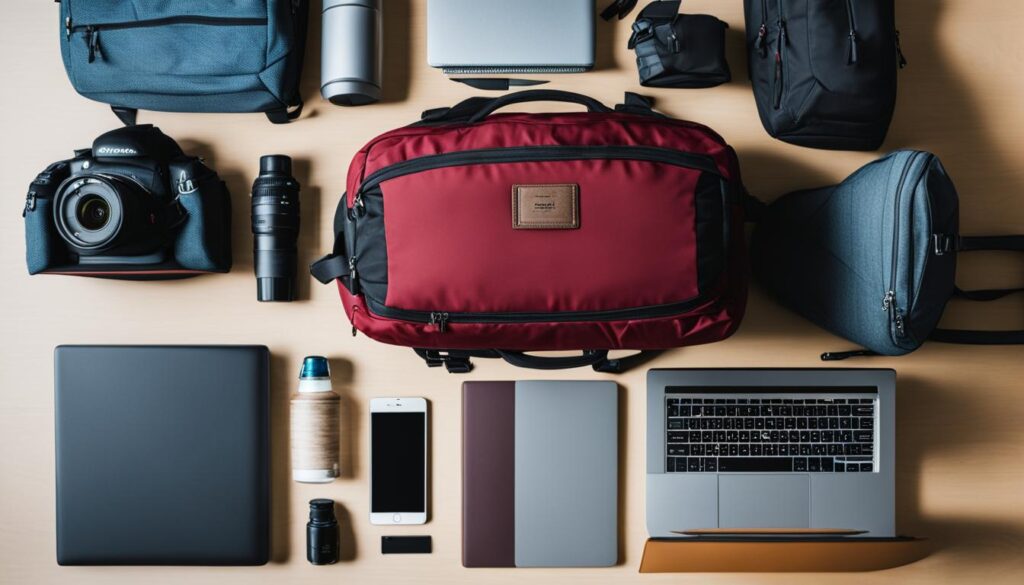
Ensuring Compliance with Airline Baggage Rules
When it comes to traveling with a carry on backpack, it’s crucial to comply with the specific baggage rules of the airline you are flying with. Failure to adhere to these regulations could result in additional fees or even the backpack being rejected outright.
Most airlines have specific size and weight restrictions for carry on luggage, including backpacks. For instance, American Airlines allows carry on bags that are no larger than 22 x 14 x 9 inches, while Delta Airlines accepts backpacks no larger than 22 x 14 x 9 inches and no heavier than 35 pounds.
It’s important to note that these regulations can vary depending on the airline, so it’s advisable to check with your specific airline for any additional rules or restrictions before packing your carry on backpack.
| Airline | Carry On Size Restrictions | Weight Restrictions |
|---|---|---|
| American Airlines | 22 x 14 x 9 inches | No weight restriction (must be able to lift above head) |
| Delta Airlines | 22 x 14 x 9 inches | 35 pounds |
| United Airlines | 22 x 14 x 9 inches | 35 pounds |
By ensuring compliance with the airline baggage rules, you can avoid any unexpected issues related to your carry on backpack and have a smooth and stress-free travel experience.
Tips for Streamlined Travel with a Carry On Backpack
Traveling with only a carry on backpack can make your journey hassle-free and streamlined. Here are some packing tips for carry on backpack that will help you make the most of your available space:
- Roll your clothes: Instead of folding your clothes, try rolling them up tightly. This not only saves space but also reduces wrinkles.
- Use packing cubes: Packing cubes are a lifesaver when it comes to organizing your backpack. You can easily separate your clothes, toiletries, and other items so that they are easy to find when you need them.
- Wear your bulkiest items: If you’re traveling with a bulky jacket or shoes, wear them while you’re on the plane. This frees up valuable space in your backpack.
- Minimize your toiletries: Opt for travel-sized toiletries or try using solid shampoo and soap bars instead of liquids. This reduces the amount of space they take up in your backpack.
- Choose versatile clothing: Pack clothes that you can mix and match to create multiple outfits. This saves space and ensures you have enough options while you’re traveling.
- Consider your electronics: If you’re traveling with multiple electronics, try to keep them to a minimum. Only pack what you’ll actually need and make sure to fully charge them before you leave.
Visual Aids
Here’s a visual representation of how to pack your carry on backpack efficiently:
“Traveling with only a carry on backpack can seem daunting, but with the right packing strategy, it can be a breeze.”
Benefits of Using a Backpack as a Carry On
If you’re a frequent traveler like me, you know how essential it is to pack light and smart. That’s why I always prefer using a backpack as a carry on instead of traditional luggage. Not only is it more practical, but it also offers numerous benefits that I can’t resist. Here are the top advantages of using a backpack as a carry on:
- Ease of movement: Carrying a backpack frees up your hands for other tasks, making it easier to move through crowded airports or navigate public transport.
- Flexibility: Backpacks can fit in overhead compartments or under the seat in front of you, giving you more options for storage.
- Convenience: You can keep all your essentials close at hand, making it easier to access important items like passports, boarding passes, and charging cables.
- Comfort: Backpacks distribute weight evenly across your back and shoulders, reducing the strain on your body during long periods of travel.
- Style: Backpacks come in a variety of styles and colors, allowing you to express your personal taste and stand out from the crowd.
As you can see, using a backpack as a carry on has many benefits that make it a great choice for any traveler. So the next time you’re thinking about packing your bags, consider swapping your traditional luggage for a backpack and enjoy the convenience and comfort it provides.
Conclusion
After exploring the specific regulations and guidelines surrounding using a backpack as a carry on, I hope you feel better equipped for your next travel adventure.
Remember to carefully consider the size of your backpack and adhere to TSA guidelines for an efficient and hassle-free airport experience. Utilize smart packing tips to make the most of your space and always double-check the airline baggage rules before heading to the airport.
Overall, there are many benefits to using a backpack as a carry on, such as ease of movement and practicality. I highly recommend trying it out for your next trip!
FAQ
Can I use a backpack as a carry on?
Yes, you can use a backpack as a carry on, as long as it meets the size restrictions set by the airline.
What are the carry on luggage size restrictions?
Carry on luggage size restrictions vary by airline, but typically range from 18-22 inches in height, 14-18 inches in width, and 8-10 inches in depth.
How do I choose the right backpack size for carry on?
When selecting a backpack for carry on, consider the airline’s size restrictions and choose a backpack that falls within those dimensions.
What are the TSA guidelines for carry on bags?
The TSA guidelines for carry on bags include rules for liquids, electronics, and prohibited items. Make sure to follow these guidelines to breeze through airport security.
What are some smart packing tips for carry on backpacks?
To maximize space in your carry on backpack, roll your clothes instead of folding them, use packing cubes, and pack only essential items.
Can I carry a backpack as a personal item?
Yes, in addition to your carry on, you can often carry a backpack as a personal item, such as a laptop bag or purse. Check with your airline for specific rules.
How do I safely carry a laptop in my carry on backpack?
To ensure the safety of your laptop, use a padded sleeve or laptop compartment within your backpack and avoid placing heavy items on top of it.
How can I ensure compliance with airline baggage rules?
To avoid any issues, make sure you are familiar with the baggage rules of the airline you are flying with and pack your carry on backpack accordingly.
What are some tips for streamlined travel with a carry on backpack?
Pack strategically, keep important items easily accessible, and use organizational tools to make your travel experience with a carry on backpack more efficient.
What are the benefits of using a backpack as a carry on?
Using a backpack as a carry on offers benefits such as ease of movement, versatility, and the ability to navigate crowded areas more easily.

